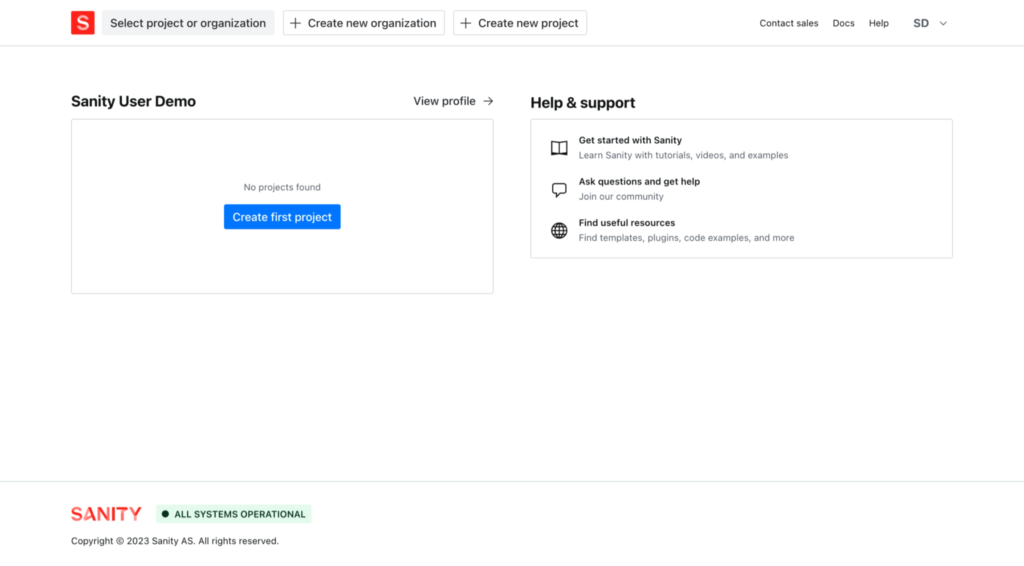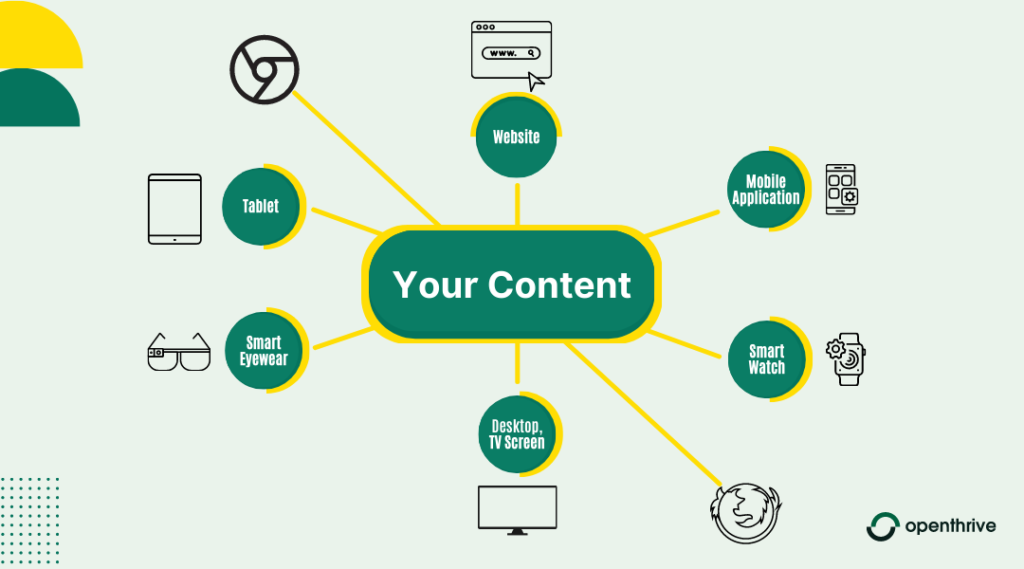According to Rebecca Lieb, Content Strategist & Author, “Content is the atomic particle of all digital marketing”.
Therefore, it has never been more critical to create digital experiences and deliver quality-bound content.
With smartphones allowing us to consume content on the go and the Internet of Things (IoT) keeping us connected from roads to workplaces, life has become easier. With businesses paying more attention to content management and overall scalability, the need for going headless has increased exponentially.
Businesses with large amounts of data and complex websites are turning to headless CMS to quickly and conveniently manage their website content with minimal technical knowledge.
But before we dive into the list of best headless CMS platforms, let’s briefly understand what it means.
The concept of a headless CMS describes a content management system that includes only the backend and does not include any front end.
Therefore, headless CMS separates the backend body of the CMS platform from the display head. Headless CMS uses a decoupled architecture that manages content in the backend but lacks a presentation layer to display content in the front.
A Headless CMS executes content on a webpage by calling an API. The API allows content to be published to web services and delivered to any channel and device. In contrast to traditional CMS such as WordPress, which integrates the front end with the backend, this is much more preferable.
Top 10 Headless CMS
Let’s look at the top 10 headless platforms that are worth every penny today and in the future.
1. Sanity

Sanity is an open-source, headless CMS and a unified content platform, built with Javascript and React.js. It’s easy to get started, either via CLI or via Sanity Starter Projects. Developers can easily customize their environment, and integrate backend APIs & data modeling features.
The WYSIWYG editor provides a simple editing experience and allows marketers to embed editable data in text, while APIs enable developers to cache multiple queries on a single request. These powerful APIs, provide fast and stable access. It has a matured tech stack – PostgreSQL, ElasticSearch, and React. Sanity also provides real-time collaboration, live previews, scalability, and security for cloud infrastructure.
To top it all, Sanity has a highly active community on Slack.
Take a look at how Sanity’s adoption has grown over the past few years.
Pricing:
Sanity offers a free plan with limited features and starts at $99/month for teams, $949/month for businesses, and can be custom priced for Enterprises.
2. Contentful
Contentful is a popular CMS that helps you build digital experiences at scale. It offers an API-driven, content-as-a-service headless CMS with a RESTful API giving developers complete control over content, assets, and translations. A rich text editor, JSON snippets, and content modeling are among the features of this headless CMS.
It has a good DX through CLI first approach, and customized content modeling, and empowers editors to work independently of development teams. Contentful’s UI extensions can help if you need to customize and enhance the user experience of the Contentful web app.
Contentful is speedy and highly efficient; users can create their own space to manage content and build custom themes for more appealing visuals. Plus, it provides high security, reliable infrastructure, and 24/7 customer service.
Pricing:
Contentful is free for developers building individual projects and starts at $300/month for teams building sites and apps and can be customized for bigger enterprises.
3. Strapi
Strapi is an open-source next-generation headless CMS built on Node.js. It lets developers create and manage multiple APIs for distributing content without frameworks or plugins to install. They can deploy it on almost any server.
The Strapi interface is intuitive, well-designed, and developer-first, providing a lightweight and highly customizable system for managing content that can be delivered anywhere on websites, apps, stores, etc.
The Strapi API is easy to use with excellent documentation, and you are free to choose where you want to keep your data.
It is also a more affordable option compared to its peers.
Pricing:
Strapi offers a free plan with limited features and has an enterprise edition starting at $9 per user per month for the bronze plan, and $29 per user per month for the silver plan, both self-hosted.
4. Hygraph
Hygraph is the first GraphQL-focused headless CMS built on content federation. Its unique federated content platform unifies, structures, enriches, and distributes data from anywhere and is accessible from any application. It allows for performative and quick UI development.
Its API approach enables enriching content with remote data delivery and easy integrations. Check this link, where you can compare any other Headless CMS with Hygraph to see the differences.
Pricing:
Hygraph has a free developer plan with limited features and the enterprise plan starts from $299 per month per project.
5. Kontent.ai
Kontent.ai is a SaaS headless CMS that has a blazing-fast CDN and simplifies content production for marketers, enabling them to integrate existing technologies and create quality content without developer help.
It’s easy to integrate with the help of the Delivery API and hence businesses can control their content, process, and security with this CMS.
With Kontent.ai, the administration is easy, and users can create content using the WYSIWYG editor’s built-in features for collaboration, workflow management, structured content, personalization, and localization. Plus it’s GDPR compliant with multi-factor authorizations and 24/7 support.
Pricing:
As far as Kontent.ai’s pricing is concerned, it offers a free trial, but for enterprise and scale editions, the pricing information is retrieved from the software provider after final cost negotiations.
6. ButterCMS
ButterCMS is a versatile CMS that uses API first to build your content management system and integrate it in 60 seconds. It comes with a WYSIWYG editor to let you create webpage content without having to write HTML codes or employ developer expertise.
It offers flexibility, with plenty of customization options and support for languages like Python, PHP, Javascript, Ruby, and more. ButterCMS also comes with built-in SEO.
Advantages include revision histories, scheduling, multi-site/environment support, content modeling, and a user-friendly editor UI/UX.
Pricing:
ButterCMS offers smooth pricing options starting at $83/month for freelancers and scaling up to $333/month for small businesses. The Enterprise edition calls for a custom quote from the provider after cost negotiations. ButterCMS has a free trial available too.
7. Contentstack
Contentstack is one of the top headless CMSs for websites that empower developers and marketers to collaborate and quickly deliver digital content, websites, and apps.
It’s a highly scalable and improved user-friendly interface and uses RESTful APIs which are well documented to integrate with the latest tech, omnichannel distribution, flexible UI/UX, and effortless team collaboration.
Features include content previews, asset management, workflow management, and collaboration — plus integrations for Salesforce, Marketo, and Eloqua. Contentstack’s customer support is available 24/7 to assist.
As per Forrester study, four organizations using Contentstack headless CMS platform demonstrated a composite ROI of 295%, wherein there were $507.3K productivity savings due to a reduction in development time, resulting in a cost savings of $2M and a profit increase of $3M.
Pricing:
Contentstack pricing doesn’t have a free plan, rather it offers a custom plan based on customer needs and requests.
8. WordPress Headless CMS
Image: WordPress headless dashboard is similar to Traditional WordPress
WordPress Headless CMS is an open-source platform that uses RestAPI to manage content. Unlike traditional WordPress, which integrates the backend with the front-end presentation layer, WordPress headless is a decoupled architecture with an API-first system. It has an existing robust system for content editing, and better DX because of familiarity.
It allows for greater control, lightweight design, increased scalability, and tighter security features. It boasts a huge active community and resource pool.
Pricing:
WordPress headless CMS features a custom pricing plan based on the hosting service taken.
9. Plasmic
Plasmic CMS is an API- first headless CMS that is directly integrated into its visual editor. It can allow rendering content anywhere and lets users drag-and-drop structured content directly into their designs.
It has one of the most potent headless, no-code visual editors, and empowers you to make stunning images and content.
Plasmic CMS enables seamless integration of no-code components with your Next.js and Gatsby codebase. It empowers teams to self-serve, and integrate anywhere and has robust performance and quality.
It provides an Optimization suite with A/B testing, targeting, and segmentation.
It allows more freedom for content creators and lesser dependency on developers.
Plasmic has a free version and offers a free trial.
Pricing:
The basic plan starts from $80 per team per month and grows up to $384 per team per month. The enterprise edition is customized as per the organization’s needs and customer requests.
10. DotCMS
DotCMS is an open-source headless hybrid CMS built on Java that delivers personalized content across multiple channels based on permission.
A content management system like dotCMS is an excellent choice if you’re building a network of global websites, an employee intranet, a customer portal, or a single webpage web application centralized in one place and distributed to any channel.
Its decoupled architecture makes it possible to edit using drag-and-drop, set up secure workflows, support multilingual features, and support multiple tenants at once. Users can manage content, images, and assets from a centralized location and deliver them via multiple channels using the API approach.
Pricing:
DotCMS is free for individuals wanting only basic features and hosting the software themselves. A dotCMS Starter package starts at $3,750 each month and is recommended for small teams and agencies. DotCMS enterprise plan is custom priced for professional organizations.
Headless CMS – The Present & The Future
A changing market today makes it necessary for brands to exert greater control over their customer data and content.
To deliver true multichannel experiences, a business needs to have a content hub or digital experience platform (DXP). It is becoming mandatory for legacy platforms to re-platform to keep up with demand, but this only leads to more problems and wasteful costs.
Brands can understand how a headless CMS works and choose an effective one to make the switch. The modern headless CMS solution is flexible, economic, and future-proof.
ReportLinker, an award-winning market research solution based out of France, estimated the global headless CMS market to be worth US$ 328.5 million in 2019 and further projected that it would reach US$ 1628.6 million by 2027. During this period, it is anticipated to grow at a CAGR of 22.6%.
Creating, managing, and distributing content online is essential for businesses to stay competitive. To be a digital champion for customers, brands should repurpose their thought processes by adapting to more versatile digital transformation where the digital front end is customizable according to customer needs.
The key factors which have influenced the growth of headless CMS in recent years are
- Increased consumer demands for omnichannel experiences
- Fast and reliable digital solutions
- The exponential growth of the business front, for B2B, B2C, and D2C alike
Headless CMS’ decoupled architecture is changing the face of digital transformation today and will stay for the long run. It’s flexible, lets you go-to-market faster, scales your content distribution without boundaries, offers super personalized customer experiences, and truly omnichannel engagement.
If you’re looking to bring home such transformational experiences to your customers and your business revenue, get in touch with us. Let’s discuss how we can do this together.
No matter what industry a business is in, its online presence plays a huge role in its success. Many businesses still don’t realize that a majority of their customers visit their website before purchasing in this day and age.
However, only a few companies have been able to utilize their website effectively.
